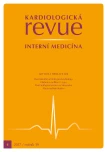Antiarrhythmic therapy in patients with atrial fibrillation
Authors:
R. Čihák
Authors‘ workplace:
Klinika kardiologie, Oddělení arytmologie, IKEM, Praha
Published in:
Kardiol Rev Int Med 2017, 19(4): 226-230
Overview
The aim of antiarrhythmic therapy in patients with atrial fibrillation is mainly to improve symptoms by heart rate and rhythm control. Rate control is often sufficient. Compared to the robust data on stroke prevention, there is very little evidence to inform the best type and intensity of rate control treatment. Both acute and long-term pharmacological rate control can be achieved with beta-blockers, digoxin, calcium channel blockers (diltiazem and verapamil), or combination therapy. Restoring and maintaining sinus rhythm is also an integral part of AF management. Propafenone, flecainide, sotalol, dronedarone and amiodarone can be used. Antiarrhythmic drugs approximately double the probability of sustained sinus rhythm compared with placebo. Catheter ablation or combination therapy is often effective when antiarrhythmic drugs fail. Although it was expected that maintaining sinus rhythm can improve the outcomes in AF patients, trials comparing rhythm control and rate control showed no difference.
Key words:
atrial fibrillation – antiarrhythmic drugs – rate control – rhythm control
Sources
1. Camm AJ, Lip GY, De Caterina R et al. 2012 focused update of the ESC Guidelines for the management of atrial fibrillation. An update of the 2010 ESC Guidelines for the management of atrial fibrillation. Eur Heart J 2012; 33(21): 2719– 2747. doi: 10.1093/ eurheartj/ ehs253.
2. Kirchhof P, Benussi S, Kotecha D et al. 2016 ESC Guidelines for the management of atrial fibrillation developed in collaboration with EACTS. Eur Heart J 2016; 37(38): 2893– 2962. doi: 10.1093/ eurheartj/ ehw210.
3. Čihák R, Haman L, Táborský M. Doporučené postupy ESC 2016 pro léčbu fibrilace síni formulované ve spolupráci s EACTS. Souhrn dokumentu připravený Českou kardiologickou společností. Cor Vasa 2016; 58: e636– e683. doi: 10.1016/ j.crvasa.2016.11.005.
4. Steinberg BA, Kim S, Thomas L et al. Increased heart rate is associated with higher mortality in patients with atrial fibrillation (AF): Results from the Outcomes Registry for Better Informed Treatment of AF (ORBIT-AF). J Am Heart Assoc 2015; 4(9): e002031. doi: 10.1161/ JAHA.115.002031.
Labels
Paediatric cardiology Internal medicine Cardiac surgery CardiologyArticle was published in
Cardiology Review

2017 Issue 4
Most read in this issue
- Myocardial ischaemia and infarction in intraventricular conduction malfunctions on ECG
- Current fixed antihypertensive two-drug combinations in Slovakia
- Modern pharmacologic treatment of type 2 diabetes mellitus
- Acute renal failure
